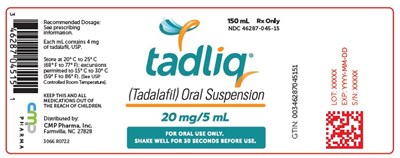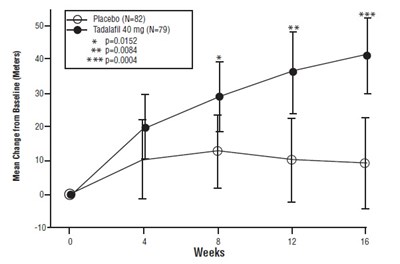Product Images Tadliq
View Photos of Packaging, Labels & Appearance
Product Label Images
The following 8 images provide visual information about the product associated with Tadliq NDC 46287-045 by Cmp Pharma, Inc., such as packaging, labeling, and the appearance of the drug itself. This resource could be helpful for medical professionals, pharmacists, and patients seeking to verify medication information and ensure they have the correct product.
Principal Display Panel - 20 mg/5 mL - tadliq cont label

This is a medication called Tadalafil used for oral consumption. Each 150mL of this medication contains 20 mg/5 mL of Tadalafil. The recommended storage temperature is between 20°C to 25°C. The medication should be kept away from the reach of children. The manufacturer of this medication is CMP Pharma, Inc., located at Fuquay-Varina, North Carolina, United States. The medication is available in Rx Only with NDC code 46287-045-15. However, there is insufficient data to understand the meaning of the words "ohmaton", "ExchmLcontins", and "Secommanded Doage".*
Figure 1 - tadliq fig1 v1

This text appears to be a chart or table documenting the effects of combining tadalafil with various medications or substances. The effects recorded include maximum decreases in systolic and diastolic blood pressure in standing or supine positions, changes in ambulatory blood pressure, and mean differences compared to a placebo. The medications listed include alfuzosin, amlodipine, angiotensin II receptor blocker, doxazosin, tamsulosin, bendroflumethiazide, enalapril, and metoprolol. The text may be useful for healthcare professionals or researchers studying the effects of tadalafil in combination with these medications.*
Figure 2 - tadliq fig2 v1

This is a table containing information about the effect of different drugs on the pharmacokinetics of Tadalafil, a medication used to treat erectile dysfunction. The table presents the impact of co-administered drugs on the area under the curve (AUC) and maximum concentration (Cmax) of Tadalafil, as well as whether a dose adjustment or avoidance of the combination is recommended. Some of the drugs listed include CYP3A inhibitors like ritonavir and ketoconazole, CYP3A inducers like rifampin, and various antacids and H2 antagonists.*
Figure 3 - tadliq fig3 v1

This is a resource that provides information regarding the effects of various coadministered drugs on the pharmacokinetics of other drugs. The drugs are classified as substrates for different cytochrome P450 enzymes, P-glycoprotein, NSAIDs, and oral contraceptives. For each drug, the AUC and Cmax values are given when coadministered with other drugs, and a recommendation is provided on whether a dose adjustment is necessary or not. The fold change relative to the coadministered drug alone is also given in the table.*
Figure 4 - tadliq fig4 v1

This appears to be a chart or table that shows the "Mean Change from Baseline (Meters)" for three different types of treatments: Fo- Placebo (n-s2), Tadalafil 40 mg, and an unknown third option. The values for each treatment are listed in the last three columns as 0152, 0084, and 0004, respectively. The table also includes some numbers (50, 40+, 0+, 20) which may indicate measurement intervals or categories, but without further context, it is not possible to determine their meaning. The asterisk at the bottom of the table signifies additional information may be available but is missing from this text.*
Figure 5 - tadliq fig5 v1

This appears to be a statistical report of a clinical trial for a drug called Tadalafil 40mg, which was tested against a placebo for the treatment of pulmonary arterial hypertension (PAH). The report includes information on subjects, their conditions, and various measures used to evaluate the effectiveness of the drug. It provides details on the change in the 6-minute walk distance and confidence intervals. The report also mentions the presence of Baseline WHO Functional Class, Gender, and Idiopathic PAH. The mention of Repaired S-P Shunts indicates a subgroup of PAH.*
* The product label images have been analyzed using a combination of traditional computing and machine learning techniques. It should be noted that the descriptions provided may not be entirely accurate as they are experimental in nature. Use the information in this page at your own discretion and risk.

